 klaus-michael schneider
klaus-michael schneider
Keywords: education |
Links: FOTW homepage | search | disclaimer and copyright | write us | mirrors

Last modified: 2021-08-26 by  klaus-michael schneider
klaus-michael schneider
Keywords: education |
Links: FOTW homepage |
search |
disclaimer and copyright |
write us |
mirrors
See Also:
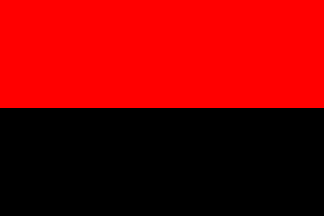 image by Ivan Sache, 9 October 2018
image by Ivan Sache, 9 October 2018
IE Integrado Carrasquilla Industrial originates in a school established in
1905 in Quibdó (Chocó Department) by Gonzalo Zúñiga, renamed to Instituto de
Pedagogía in 1907 and to Colegio Ricardo Carrasquilla in 1912. Instituto
Integrado Carrasquilla Industrial was established by Decree No. 400 adopted on
20 March 1968, incorporating Escuela Industrial (est. 1950).
The flag of
IE Integrado Carrasquilla Industrial is horizontally divided red-black. Red
represents the blood shed by heroes. Black is the color of our race.
http://www.carrasquillaindustrial.edu.co/index.php/nuestra-institucion/quiz
School website
Ivan Sache, 9 October 2018
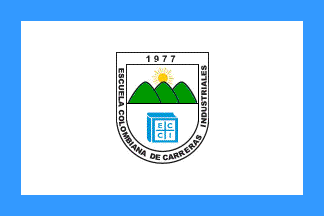 image by Ivan Sache, 17 December 2008
image by Ivan Sache, 17 December 2008
"Escuela Colombiana de Carreras Industríales"
(ECCI), founded in 1977 in Bogotá, was recognized by the
Ministry of National Education on 25 October 1978 (Decree No.
15572) as "Escuela Colombiana de Carreras Intermedias"
and confirmed under its present name on 28 March 1985 (Decree No.
2683). ECCI provides professional technical education in
industrial mechanics, computer science, telecommunications,
environmental development, entrepreneurial development, fashion
design, tax and customs management, and international trade and
negotiation. ECCI signed on 22 September 1995 a partnership
agreement with the Santiago University of Cali.
The flag of ECCI, as shown graphically on the ECCI
website, is white with a thin blue border and the emblem of
the ECCI in the middle.
The emblem of ECCI shows "the sun of hope enlighting the
country" over three green mounds representing the three
cordilleras of Colombia. Below is placed the blue book, indeed
the logo of ECCI. The border of the shield bears the foundation
year and the name of the institute in black capital letters.
The logo of ECCI is a blue book, symbolizing knowledge, whose
cover is quartered by a cross symbolizing the faith in Jesus and
the letters "E", "C", "C" and
"I" in the respective quarters.
Ivan Sache, 17 December 2008
Fundación Instituto Superior de Carreras Técnicas (INSUTEC) was established
in 1977 by Carmen Patricia Chiriví Pinzón, Luz Helena Ballestas de Vargas, and
Luis Hernando Ballestas Rincón. The institute was officially approved by
Resolution No. 6,366 of 20 April 1979.
All members of the academic community are invited to select the flag of the
institute, via a (password-protected) website. Deadline for the votes is 30
October 2014.
Source:
http://www.insutec.edu.co/site/290 - Institute's website
Ivan Sache, 29 October 2014
 image by Ivan Sache, 05 July 2011
image by Ivan Sache, 05 July 2011
"Escuela Normal Superior de Cartagena de Indías" was founded on 1 February
1848 in Cartagena de Indías (Bolívar Department).
The flag of the institute is presented graphically on the "Manuel de Convivencia"
as a square flag, horizontally divided light blue-white.
Source:
http://www.slideshare.net/norsupcarindias/manual-de-convivencia-3285205
Ivan Sache, 05 July 2011
The CASD (Centro Auxiliares de Servicios Docentes) program was established by
State Decree No. 327 of 19 February 1979. Twenty-three centers were created in
the main town of the country, each of them connecting a network of schools. The
Quindío CASD was inaugurated in Armenia in 1981, providing support in the areas
of Industry, Health and Nutrition, Commerce, and Life Sciences to 12 schools.
Institución Educativa CASD was eventually established by Resolution No. 330 of
16 April 2004.
The public competition for the design of the flag and anthem of CASD is open to
the institute's educative community. Proposals should be submitted from 5
September to 14 October 2014. The proposals will be reviewed from 16 to 24
October. The winning designs will be proclaimed on 28 October and unveiled on 14
November, during the "Night of the Majors" institutional event.
Source:
http://www.casdquindio.edu.co/?mod=p&id=165&t=n&r=b - Institute's website
Ivan Sache, 04 October 2014
"Cartagena International School was established in 1983 in Cartagena".
Source:
https://www.cartagenainternationalschool.edu.co/historia
The flag is
a horizontal blue flag with a golden stripe all around the edges, with the logo
(https://www.cartagenainternationalschool.edu.co/public/template/images/logo.png)
in the middle, as seen here (second flag from left to right):
https://i.ytimg.com/vi/c43j7coY00M/maxresdefault.jpg (source:
https://www.youtube.com/watch?v=c43j7coY00M, from 0:00 onwards).
The
coat of arms is described at
https://yt3.ggpht.com
Source:
https://www.cartagenainternationalschool.edu.co/nuestros-simbolos
For additional information go to Cartagena International School (official
website):
https://www.cartagenainternationalschool.edu.co/
Esteban Rivera,
26 July 2018
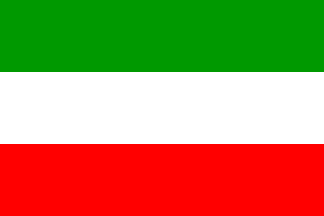 image by Ivan Sache, 12 September 2014
image by Ivan Sache, 12 September 2014
Colegio Nacional Académico de Cartago was established on 5 September 1839 by
Presidential Decree, replacing a Franciscan convent. Incorporated to the
National University in 1887, the institute was transferred in March 1887 to the
Society of Jesus. Suspended in 1891 by National Decree No. 452 because of the "lack
of subordination to discipline by the students" , the institute was renamed in
1897 Liceo del Quindo, and eventually closed in 1912 and replaced by an Escuela
Superior where agriculture and mechanics were taught, re-established the next
year, the Liceo regained its autonomy in 1915. The institute was nationalized on
1 October 1939. Institución Educativa Académico was eventually established by
Resolution No. 1,664 of 3 September 2002, as the merger of Colegio Nacional
Académico, Centro Docente No. 48 Antonio José de Sucre, Centro Docente No. 47
Paulina Balcázar, and Centro Docente Roberto Castaño.
Source: http://www.ieacademico.edu.co
- Institute's website
The symbols of the institute are prescribed by Resolution No. 14 of 14 April
2010. The flag is prescribed in Article 2 as horizontally divided "vert (green)
- argent (white) - gules (red)". Green is a symbol of faith, friendship,
service, respect, youth, and hope. White is a symbol of purity, integrity,
obedience, firmness, and eloquence. Red is a symbol of force, victory,
audacity, and highness.
Source:
http://www.ieacademico.edu.co/index.php?ir=simbolos - Institute's website
Ivan Sache, 12 September 2014
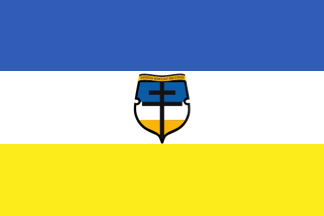 image by
Ivan Sache, 5 October 2019
image by
Ivan Sache, 5 October 2019
The Universidad Católica de Colombia was established in March 1970 in Bogotá
by Humberto Álvarez Rico, Alfonso Arango Henao, Olmedo Bedoya Piedrahíta,
Lorenzo Botero Jaramillo, Álvaro León Cajiao Bolaños, Aristides Castillo
Castillo, Carlos Delgado Fernández, Hernán García Piedrahíta, Gilberto Giraldo
Herrera, Édgar Gómez Betancourt, Álvaro Gómez Hurtado, Henry Henao Jaramillo,
Aurelio Manotas Morales, Juan Manuel Pachón Rubiano, Ángel María Quintero
Hernández, Emigdio Rincón Gómez, Pedro Felipe Valencia and Jorge Vives Abello.
Inaugurated on 2 April 1970 as the Fundación Educacional Interamericana Católica
de Colombia, the institute was granted the university status by Resolution No.
15,647, issued in 1983 by the Ministry of National Education.
https://www.ucatolica.edu.co/
Official website
The flag of the Universidad Católica de Colombia is
horizontally divided blue-white-yellow with the university's coat of arms in the
white stripe.
Photo
https://www.ucatolica.edu.co/portal/u-catolica-de-colombia-participara-en-los-xxv-juegos-nacionales-universitarios/
The coat of arms of the Universidad Católica de Colombia is described in
Chapter 2.4. of the Manual de Imagen Institucional, last revised in 2016.
Designed in 1970 by the philosopher Ángel María Quintero Hernández, funding
member and author of the declaration of principles of the institute, the coat of
arms was modernized in 2008. The coat of arms is composed of three horizontal
stripes, blue, white, and yellow. Blue and white are associated with the
Immaculate Conception of Virgin Mary. Heraldically, blue represents time
projection and the infinite, while white, equivalent to silver, represents
purity and honesty as features of the university. Yellow recalls the flag of the
Holy See, emphasizing the adhesion of the university to papacy and to St.
Peter's chair. Heraldically, yellow, equivalent to gold, is a symbol of the
spiritual resources proper to academia, maximum when inspired by the Catholic
principles. The shield's field is charged by a Cross of Lorraine, a symbol of
the triumph of truth over lie, of good over evil, of life over death, and of
liberty over totalitarianism. Heraldically, the smaller arms of the cross
represents the monogram "INRI", which is a recognition of the royalty of Jesus
Christ. The shield is surmounted by the motto "SAPIENTIA AEDIFICAVIT SIBI DOMUM"
(Wisdom hath built herself a house; Proverbs, 9,1).
The colors are
prescribed in Chapter 3 of the Manual de Imagen Institucional as:
Golden
yellow
Pantone 1235
CMYK 0-31-98-0
RGB 232-186-25
Blue
Pantone 300C
CMYK 99-50--0-0
RGB 0-103-173
https://www.ucatolica.edu.co/portal/wp-content/uploads/adjuntos/reglamentos-y-estatutos/manual-imagen-institucional.pdf
Manual de Imagen Institucional|
Ivan Sache, 5 October 2019
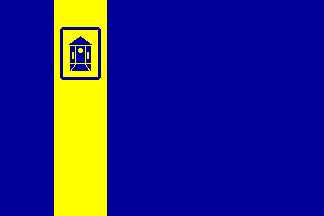 image by Ivan Sache, 25 May 2018
image by Ivan Sache, 25 May 2018
Universidad Católica de Manizales (UCM) was established on 11 February 1954,
as Universidad Católica Femenina, by Sister María de la Santísima Trinidad, a
member of the Dominican Sisters of the Presentation of the Blessed Virgin, a
congregation founded in 1696 by Marie Poussepin (1653-1744; beatified on 20
November 1994 by Pope John Paul II and awarded the title of "Charity's Social
Apostle").
http://www.ucm.edu.co/, UCM
website
The flag of UCM is horizontally divided blue-white-green with a
red fimbriation and the symbol taken from the university's coat of arms in the
center. Blue is the color of the congregation managing UCM, as the color of its
patron saint, the Blessed Virgin. White is the color of the coffee flower and of
the snow-capped mountains ("nevados"). Green is the color of the coffee foliage
and of the land's greenness. Red is the color of the ripe coffee berries and of
the youth's ardent blood.
http://www.ucm.edu.co/la-universidad/simbolos-institucionales/, UCM website
The symbol of UCM is made of a French shield, recalling the country of
origin of Marie Poussepin, the founder of the congregation managing UCM. The
green background symbolizes hope, creativity, constancy and intrepidity; in the
middle is placed the graphic element, made of a cross, symbol of Jesus Christ,
of a "U" for "Universality" and "University", and of a "C" for "Catholic" and
"Christian". This graphic element was used as the university's coat of arms
until 1998.
The blue bordure, as a symbol of protection, favor and
reward, uses the blue color of the Blessed Virgin. Blue also symbolizes justice,
sweetness, loyalty and piety. The red fimbriation represents strength, valor,
fidelity, joy and honor. Red is also the color of the coffee berries. The golden
scroll is a symbol of nobleness and charity. The motto "Verdad Caridad" reads
"Truth Charity".
http://www.ucm.edu.co/wp-content/uploads/docs/manual_identidad_ucm.pdf
Manual de Identitad Corporative, UCM
The connection of colors with coffee
recalls that Manizales is one of the cradle of coffee cultivation in Colombia,
as part of the Coffee Triangle.
Ivan Sache, 25 May 2018
 image by Ivan Sache, 05 July 2011
image by Ivan Sache, 05 July 2011
Law 48 issued in 1945 prescribed the foundation of four
"Colegios Mayores" of Cundinamarca (in Bogotá),
Antioquia (in Medellín), Bolívar (in Carthagena) and Cauca (in
Popayán). The most recent of the four institutes, "Colegio
Mayor del Cauca" was inaugurated on 13 November 1967 as
"Colegio Mayor de Cultura Popular del Cauca".
The flag of the institute,
as shown graphically and described on the website
of the institute, is vertically divided blue-yellow-blue with the
institute's
logotype in the top of the yellow stripe. The first two stripes
seem to be of the same width and the third one much wider.
Yellow is the colour of the sun, of light, life, action and
power. It symbolizes strength, will and stimulation. It
represents the human intelligence enlightened by the divine
revelation. According to Vincent Van Gogh, yellow represents
"friendship and love".
Blue represents intelligence and deep emotions. It is the colour
of the infinite and of the dreams. It symbolizes wisdom,
loyalty, eternal truth and immortality.
The first logotype of the institute was prescribed by Decree No. 019 of the Board of
Directors, adopted on 1 November 2001. It represents "El Camarín" framed in a white rectangle with a blue border
outlined in yellow and charged with the name of the institute in
white capital letters.
"El Camarín", lit. the Cabinet, was designed in 1760
by the German architect Simon Schendherr on the facade of the
second floor of the Church of the Incarnation. It represents the
communication between the inside and outside words. "El
Camarín" has three windows, two rectangle on the sides and
one circular in the main axis, symbolizing a large eye always
watching the ever changing cosmos.
Ivan Sache, 16 December 2008
The current logotype was adopted in 2009 by the Board of Directors. It
features a schematic, blue representation of "El Camarín" placed on a yellow
background and framed with a blue rectangle with rounded-off angles.
http://www.colmayorcauca.edu.co/unimayor/page/logotipo - Logotype
Photos
http://proyecciondelcauca.com/popayan.php?id=417
http://www.colmayorcauca.edu.co/unimayor/page/edificio-bicentenario
http://www.proclamadelcauca.com/2011/11/el-colegio-mayor-es-un-emblema-del.html
http://www.mineducacion.gov.co/cvn/1665/w3-article-323355.html
Ivan
Sache, 22 July 2014
In 2008 the Colegio Mayor del Cauca evolves from an Institución Tecnológica
(English: Technological Institution) to an Institución Universitaria (English:
University Institution) (source:
https://www.youtube.com/watch?v=uppV_VfAvmI) and has started to use the
initial UNIMAYOR (standing for Universidad Mayor, instead of Colegio Mayor).
The meaning of the flag is as follows (translated from the original in
Spanish):
"Meaning of (the) colors:
Yellow: It is the color of light, of
the sun, of life, action, power. It symbolizes strength, will and encouragement.
It represents human intelligence illuminated by divine revelation. (It is an)
Intellectual color. According to Vincet Van Gogh yellow "represents friendship
and love". It is a tolerable and cheerful color in small areas.
Blue: It is
related to intelligence and deep emotions. It is the color of the infinite, of
dreams and of the marvelous and symbolizes wisdom, fidelity, eternal truth and
immortality. The blue color does not change with distance and can be used
without fatigue in large areas"
Source:
http://www.unimayor.edu.co/web/unimayor/la-institucion/simbolos/bandera
For additional information go to UNIMAYOR (official website):
http://www.unimayor.edu.co/
Esteban Rivera, 28 January 2019
"Corporación Universitaria Autonoma del
Cauca", recognized by the Ministry of National
Education on 7 April 2003 (Decree No. 677), is the legal sucessor
of "Corporación UCICA", founded in 1979 in Popayán
and recognized by the Ministry of National Education in 1984
(Decree No. 13002).
The flag of the
university, as shown graphically on the university's
website, is blue with four thin yellow stripes in the lower
part of the flag and the emblem of the university in the middle.
The emblem of the university is a blue shield with stylized
yellow letters "C" and "A" surrounding a blue
sphere. The shield is surmonted by the name of the university in
yellow letters.
Ivan Sache, 18 December 2008
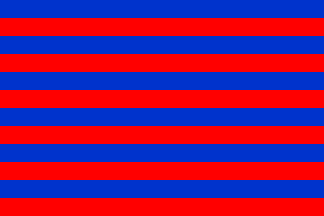 image by Carlos Thompson, 22 March 2003
image by Carlos Thompson, 22 March 2003
Acording to the site of the Universidad del Cauca www.unicauca.edu.co,
the flag has 12 stripes.
From the site: "Formada por doce barras azules y rojas de
igual tamano, alternadas y colocadas perpendicularmente al asta,
fue adoptada en la misma fecha y por el mismo Acuerdo de Alta
Corporación Universitaria, con ocasión de conmemorarse un ano
más de su fundación del Alma Mater." [Formed by twelve
equalsized stripes alterned blue and red, perpendicular to the
hoist, was adopted the same date (November 7, 1922) and by the
same Agreement of High University Corporation (Consejo Directivo
Universitario) in conmemoration of one more year of the foundation
of the Alma Mater.]
Carlos Thompson, 22 March 2003
Universidad del Cauca was founded in Popayán on 11 November
1827. Among his famous alumni are Presidents of the Republic
José Hilario López Valdes (1849-1853), Ezequiel Hurtado (1864),
Julián Trujillo (1878-1880) and Guillermo León Valencia
(1962-1966).
The flag in real use is shown in several scenes of the video
celebrating the university's 180th anniversary.
Ivan Sache, 6 February 2010
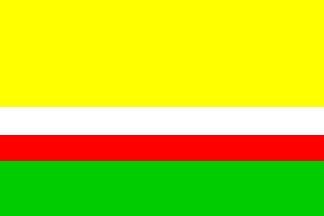 image by Ivan Sache, 28 July 2014
image by Ivan Sache, 28 July 2014
Liceo Caucasia is located in Caucasia (Antioquia Department).
The flag of the institute is horizontally divided (4:1:1:2)
yellow-white-red-green. Yellow is a symbol of spiritual resources. White is a
symbol of peace, tranquility, and of the search for interior spirituality. Red
is a symbol of cultural struggle against ignorance, and of clarity and splendour
of knowledge. Green is a symbol of aspiration to a better future.
Source:
http://liceocaucasia2012.blogspot.fr/2012/12/la-bandera-de-la-ie-liceo-caucasia.html
- Walter Tuiran's blog
Ivan Sache, 28 July 2014